Endangered Indics in India – an Overview
- In History & Culture
- 03:23 PM, Oct 03, 2017
- Shanmukh, Kirtivardhan Dave, Saswati Sarkar, & Dikgaj
Introduction
Since the first rigorous census in 1872 was carried out in the then United India, the Indics have been falling in total population share in India. Over the years, Indics have disappeared from, or been greatly reduced in, many parts of India. Some of it has been due to emigration of Indics from the region, either voluntarily or under pressure. Other reasons include wholesale conversion of the Indics of many regions.
First, we define the word Indics. Indics are all those religions that have had their origins in the Indian subcontinent. This includes the Hindus, the Sikhs, the Buddhists, the Jains and the various tribal religions. Jews and Zoroastrians have not been included in the Indic class, but they are in such small numbers that their inclusion or exclusion is only a matter of academic importance; their numbers do not affect the demographic statistics in any way.
In 1872, Indics constituted the majority in all states except North-West Frontier Province, Sindh, Baluchistan and Jammu & Kashmir. In both Punjab and Bengal, Indics constituted clear majority. In Bengal, Indics formed 50.14% of the total population [1] and in Punjab, the Indics formed 52% of the total populatin in 1881 [2]. However, this had changed drastically by 1941. Indics constituted only 45.21% of the total population in 1931 in Bengal and in Punjab, Indics were 44.9% of the total population in 1941.
On an all India level, too, Indics fell from 79% of the total population in 1872 to 73.2% in 1941 [3], to ~66% in 2011.[4],[5]. The two graphs below show how the share of the Indic population fell from 1881 to 1941, while that of both Muslims and Christians rose. Muslims rose from 19.9% to 24.3%, while Christians rose from 0.7% to 1.9% in 1941.
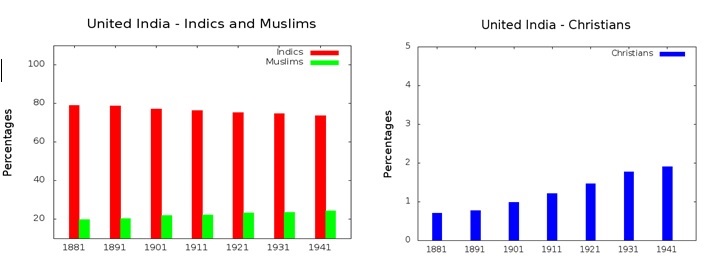
It is important to realise that the fall of the Indic population in both Bengal and Punjab was one of the principal causes of Partition. It would have been far harder to partition the country if both Punjab and Bengal had remained Indic majority, as was the case in 1872. Sindh, Jammu and Kashmir, North West Frontier Province and Baluchistan, between them would not have constituted a viable state and further, Kashmir was ruled by the Hindu Dogra rulers who would not have entertained such a proposal. The tragic consequence of this fall of Indic population in India was Partition.
The Partition resulted in the greatest humanitarian disaster in this country. It resulted in a disaster whose casualty figure has been estimated at 10 lakh killed and 1.8 crore displaced. p. 243, [34]. Further, the total number of atrocities on women was also huge. This humanitarian disaster was occasioned by the fall of the number of Indics in India.
In the aftermath of the Partition, Indics have almost disappeared from Pakistan. From 19.68% in 1941 in Pakistan, Indic population has come down to ~2% in 1998 [3]. The collapse in Bangladesh has been just as severe. From 29% in 1931 [3], the Indic population has come down to 8.9% in 2011 [5]. Even in the Indian Union, the Indic population has been falling since 1951. The two graphs below show that the fall of Indic population in the Indian Union since 1951 and the rise of Muslim population since then. Indics have fallen from 87.2% in 1951 to 83.2% in 2011. On paper, the Christian population has remained steady at 2.3%. However, many Christian sites claim that the percentage of Christians in India is 6% [36]. The latter claim, however, is impossible to validate. Given these historical facts and current data, the fall of the Indic population is indeed a matter of serious concern.
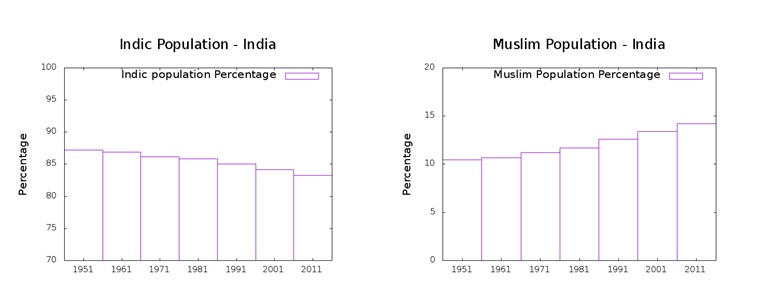
In the case of the Indian Union, the reduction of the Indics has not been uniform. While the population share of the Indics has fallen almost everywhere in the Indian Union, the fall has been far greater in certain parts of the country, to the extent that they have almost disappeared from certain regions. In 1951, there were two states in India (Jammu and Kashmir, and Mizoram), and one Union Territory (Lakshadweep) that were Indic minority. In 2011, there are four Indian states (Jammu and Kashmir, Mizoram, Nagaland and Meghalaya) and one Union Territory (Lakshadweep) that are Indic minority. In addition, there are two more states that have Indics between 50% and 60% (Manipur and Kerala). In this article, we analyse the changes in the Indic population in the various states and the consequences thereof.
The analysis presented here is only based on two census; namely, the 2001 census and the 2011 census, to show how the changes have been occurring. We analyse the changes at a statewide level, a district wide level and at a tehsil level, so that both micro and macro changes can be captured and analysed.
Overall Indic Population
First, we have grouped the Indic population as living in tehsils where Indics are borderline (50-60%), where Indics are a minority (20-50%), and where Indics have been wiped out (<20%). These have been grouped by the states in the tables given below. On the map, the tehsils where Indics have been wiped out have been coloured red, the tehsils where Indics are a minority are coloured dark green and the tehsils where Indics are on the borderline are marked in light green. The regions where Indics constitute more than 60% are marked in white. The map below gives a good idea where the bulk of the regions where Indics are living in areas that are <20% Indic, 20-50% Indic, and 50-60% Indic, both for 2001 and 2011 census. The changes between the two census can also be remarked.

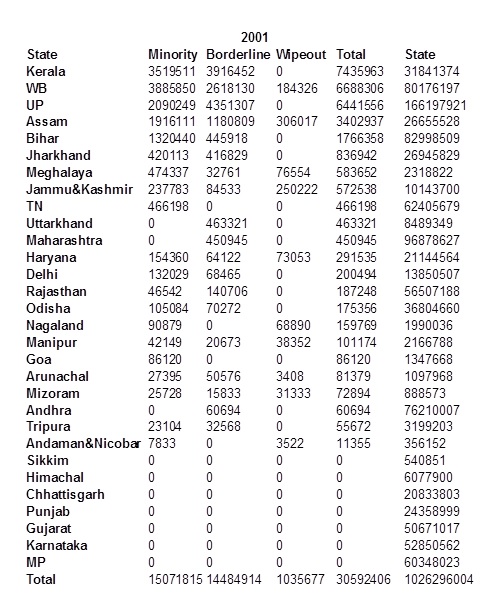
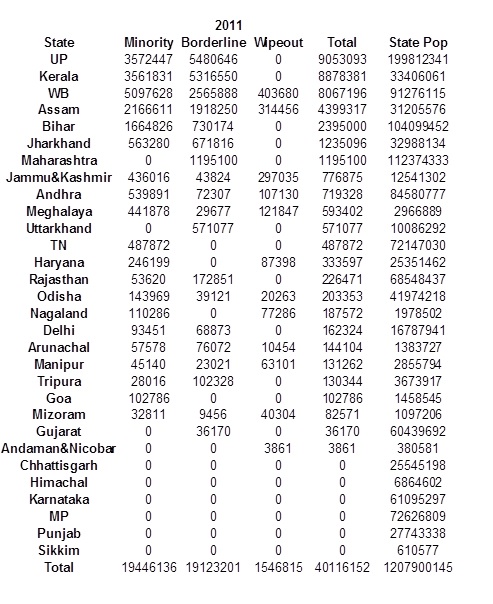
The above two maps and tables respectively show how the Indic population living in borderline and minority areas have increased in the decade. Overall, the total Indic population living in borderline and minority areas rose from 3.06 crores to 4.01 crores, with the rise being nearly a third from the previous decadal census. In every category, the population rose. It must be emphasised that there are very few tehsils where the situation of the Indics has improved.
In the above tables, the following facts come to light. The number of Indics living in areas where Indics are borderline (50-60%) rose from 1.45 to 1.91 crores in the 2001-11 decade, a rise of 31.7% and the number of Indics living in Indic minority areas (20-50% Indic) rose from 1.51 crores to 1.94 crores in the 2001-11 decade, a rise of 28.4%. The rise of the total population of India was 17.6% in the 2001-11 decade and in the regions where Indics are <60%, Indic population growth has been generally much less than the average national growth. However, what is genuinely worrying is the rise of the number of the Indics living in areas where Indics have been practically wiped out (<20% Indic). It rose from 10.36 lakhs to 15.47 lakhs, a rise of 49.11%, which is nearly three times the decadal population growth rate. This implies that the number of regions where Indics are being wiped out is spreading, a fact proven by the map shown above. The tehsils marked in red have increased between 2001 and 2011, from 193 to 265, a rise of 37.3%. While some of the rise in the number of tehsils is due to to the creation of new tehsils in the regions where Indics have been wiped out, it is undeniable, just by looking at the map that the area where Indics have been wiped out is spreading. We shall show later in the article that the Indics becoming minorities, especially falling below 20%, has very serious implications for their security.
In fact, it is clear that in some states the fall of Indics has been drastic, even in just the 2001-11 decade. Below, we have shown the Assam, Kerala and Arunachal Pradesh maps of 2001 and 2011. The change should indicate the rate at which the Hindu population has been decreasing in these regions.
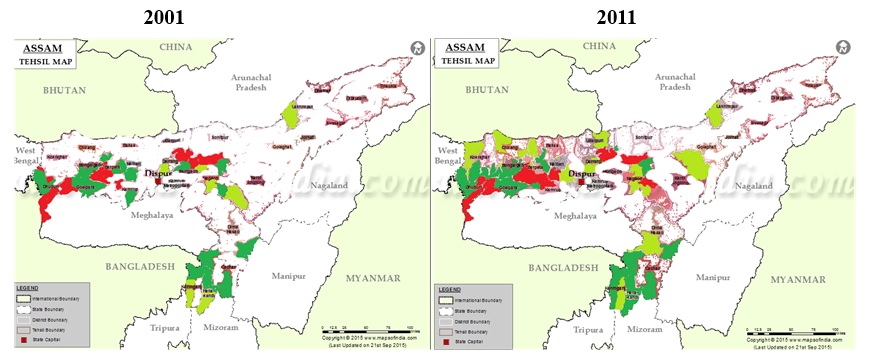
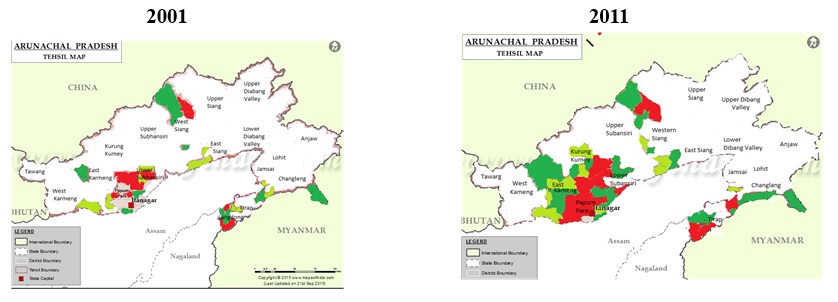
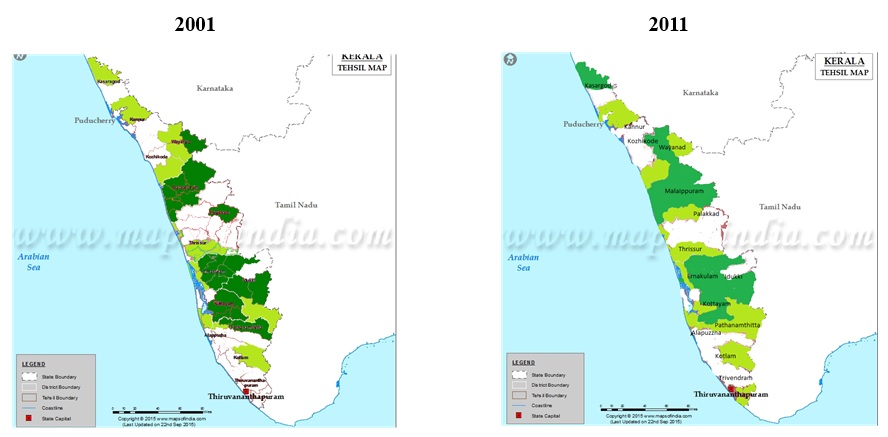
As may be observed from the above maps, in all the three states large areas that were not Indic minority or where Indics were not endangered have entered the list. We highlight these maps to indicate the degree of the threat. The states have been analysed in detail in the subsequent sections of the article.
Andaman and Nicobar
In Andaman and Nicobar, the number of Indics in the Indic minority/wiped out areas have come came down, but this was is due to artefacts because Nancowry and Car Nicobar were both split with Indic minority areas made new tehsils. The entire tehsils of Nancowry and Car Nicobar have been converted, so that there are few Indics left to be minority even. Out of the 3 tehsils in the Nicobars, Indics had been wiped out in 2 of them. The tehsils of interest are marked in red. However, the tehsils were merged in 2001, so we once more cannot analyse the difference between 2001 and 2011 accurately.
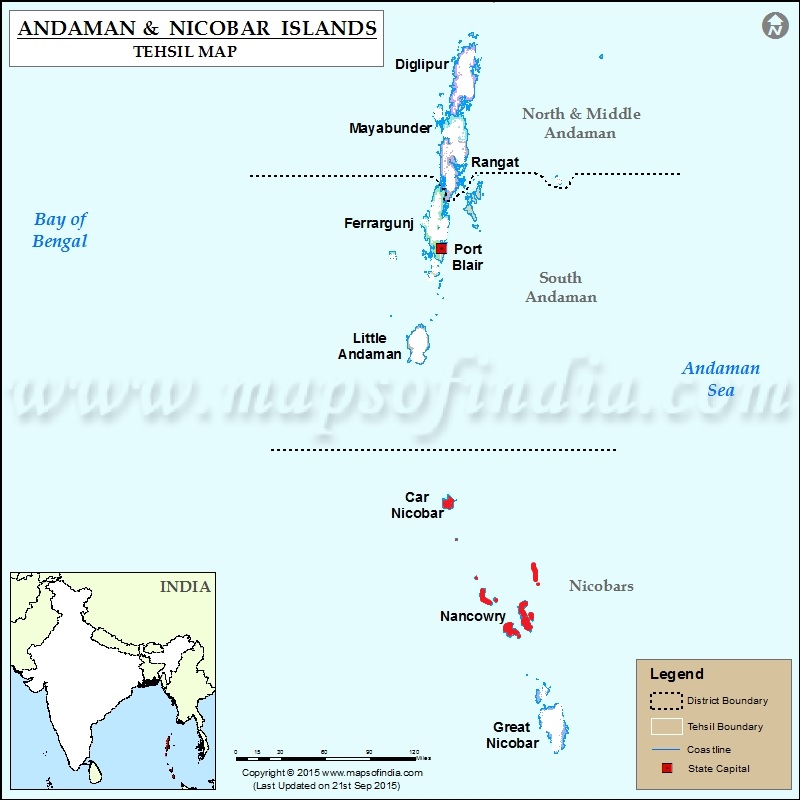
North Eastern States
In the North East, Indics have been essentially wiped out in both in Nagaland, Mizoram and have greatly shrunk in Meghalaya, to the point that the Indics are minorities are in all the three states. The Indic population of Manipur and Arunachal Pradesh has also greatly fallen, and indeed, in Manipur, the Indic population is just above the half way mark. The figure below shows the extent to which the Indic population has fallen. In Arunachal, Christians are the plurality now. Even in the relatively better off Sikkim, about 10% of the total population has been converted to Christainity. Only Tripura has Christians at 4.35%. About 12% of the tribals of Tripura have converted to Chrisitianity. Overall, from over 95% in 1901, Indics now constitute around 53% of the total population in the north east. Christians constitute 45.03%. Muslims, except for very small pockets like Lilong valley in Manipur and western fringes of Meghalaya are not a factor here, for the most part, though. The fall of the Indics in the north east is one of the least observed phenomena, though.
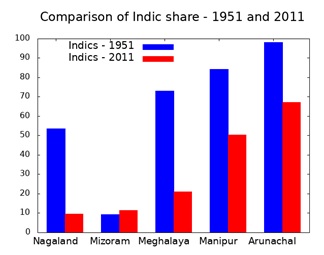
Mizoram
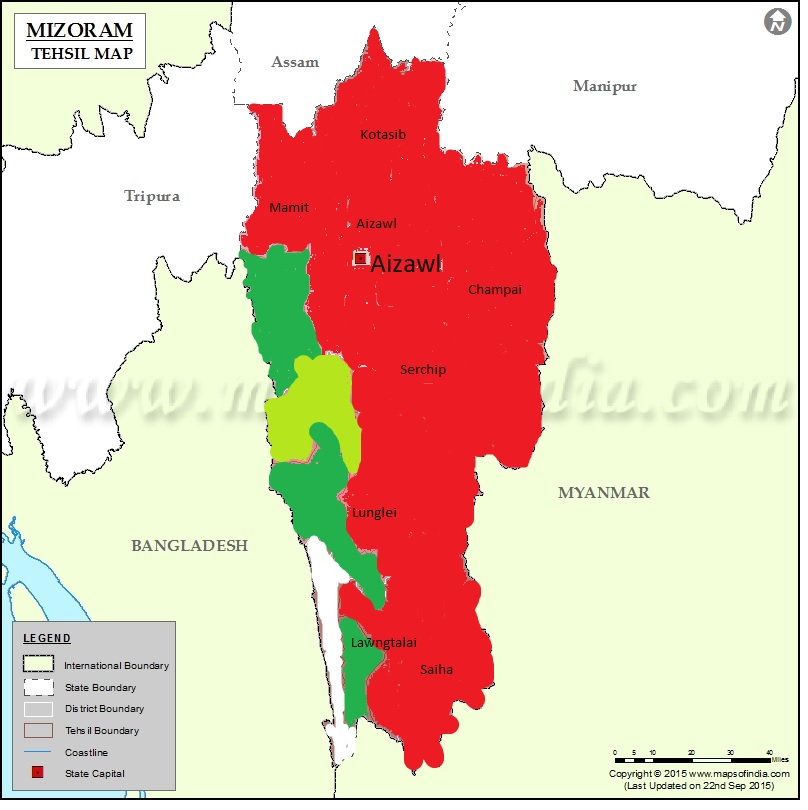
Mizoram is a state where Indics have been essentially wiped out. Indics are below 20% in all the interior regions of the state (20 tehsils) and have essentially been wiped out. Indics are minorities in 3 more tehsils, where they constitute 20-50% and these are all situated on the Bangladesh border. Indics are a majority in only two tehsils and above 60% in only one tehsil adjoining Bangladesh (due to the Buddhist Chakmas, who have resisted conversion). Reangs, a Hindu tribe living on the Tripura border, constituted the last unconverted indigenous tribal group. They have been expelled from the state to Tripura by Christian terrorists.
Nagaland
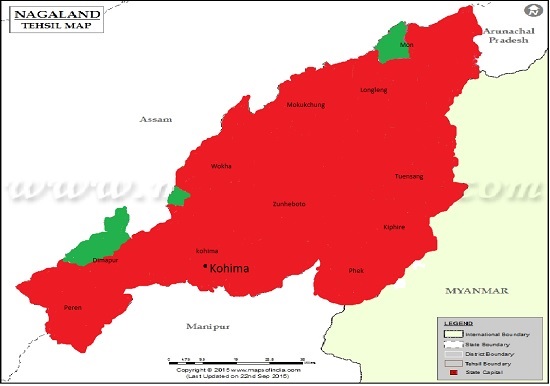
In Nagaland, all the tehsils are Indic minority. In 1951, Indics constituted 53% of the total population of Nagaland. It has since been reduced to 9% in 2011. None of the tehsils are Indic majority anymore, not even Dimapur with its large Hindu Dimasa population and its historical relations to Asom. Dimapur has 42% Indics. All others have far smaller Indic populations and Indics have been completely wiped out in Naga areas.
Meghalaya

Meghalaya has seen one of the sharpest fall of Indics in the history of independent India. From 73% in 1951, the Indic population has fallen to ~21% in 2011. Of the 39 tehsils in Meghalaya, 37 are Indic minority. One (Pynursla) is borderline and only one – Khatarshnong Laitkroh – is Indic majority. These two tehsils are populated mostly by the Seng Khasi. However, even in 2001, the tehsils were all Indic minority already, except for these two. Meghalaya has three major tribes – the Garos, the Khasis, and the Jayantias, and the conversion of the Indics – especially the Garos and Khasis – has been nearly total, with only the Seng Khasi holding out. Among the Jayantias, too, a very large proportion has converted too, but there is still a significant proportion unconverted.
Manipur
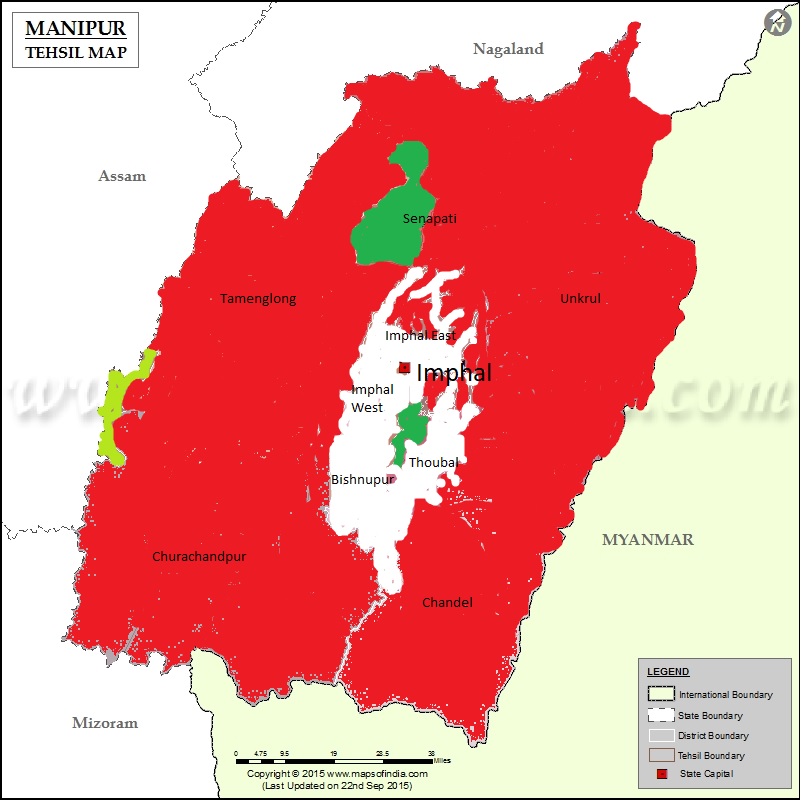
Manipur is still Indic majority, but only just. Indic population has fallen from 84% in 1951 to 50.3% in 2011, and in the next census, will be Christian plurality. Outer Manipur has been totally converted, with only one tehsil on the Assam border remaining borderline Indic. Only Inner Manipur – the Imphal Valley – dominated by the Meiteis, has remained Indic (Hindu and Sanamahi). The Meiteis are probably the only significant ethnic group in the north east outside Asom that has resisted conversion.
Arunachal Pradesh
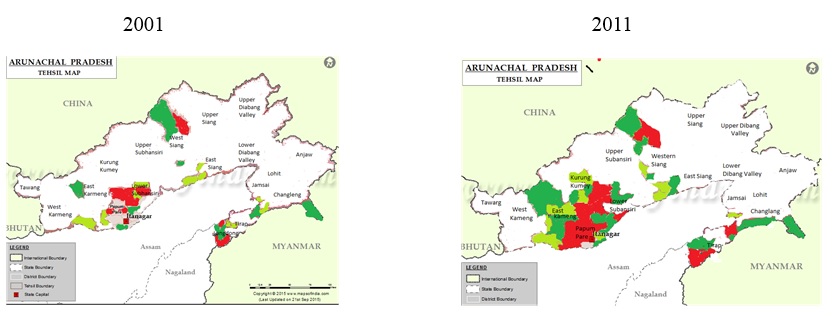
Arunachal Pradesh had no Christian population of significance until 1971; indeed, Christian population was ~0.1% in 1971. It rose to 4% in 1981, 10% in 1991, 18% in 2011 and 34% in 2011. The difference between 2001 and 2011 can be seen in the maps shown above. In contrast, the Hindu, Buddhist and Animist population shares of the state are rapidly falling and Christians are now the plurality in Arunachal Pradesh. Christianity is rapidly replacing the unique faith of the region, Donyi Polo, in its rapid spread. At this rate, Christianity may well cross the half way mark by 2031 at the latest.
States with Non-Hindu Pockets
Odisha
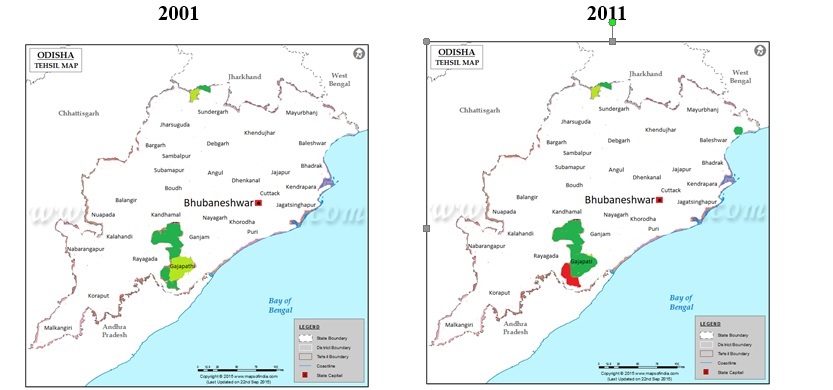
Both the northern and the southern tribal belts of Odisha are rapidly showing change due to conversions. Gajapati district in the south has many Indic free areas now, with the conversion being total, even in the decade in question. Further, it is important to point out that Gajapat lost 6% Indics in just the 2001-11 decade, which is a huge fall of Indics. Kandhamal, just north of the Gajapati district, has also been seriously affected by the conversions. Other districts such as Rayagada and Koraput also have developed 5-10% Christians in total in the last few decades. In the north, the Sundargarh region also shows a high number of conversions, and borders the Ranchi belt of tribal converts in Jharkhand.
Tamizh Nadu
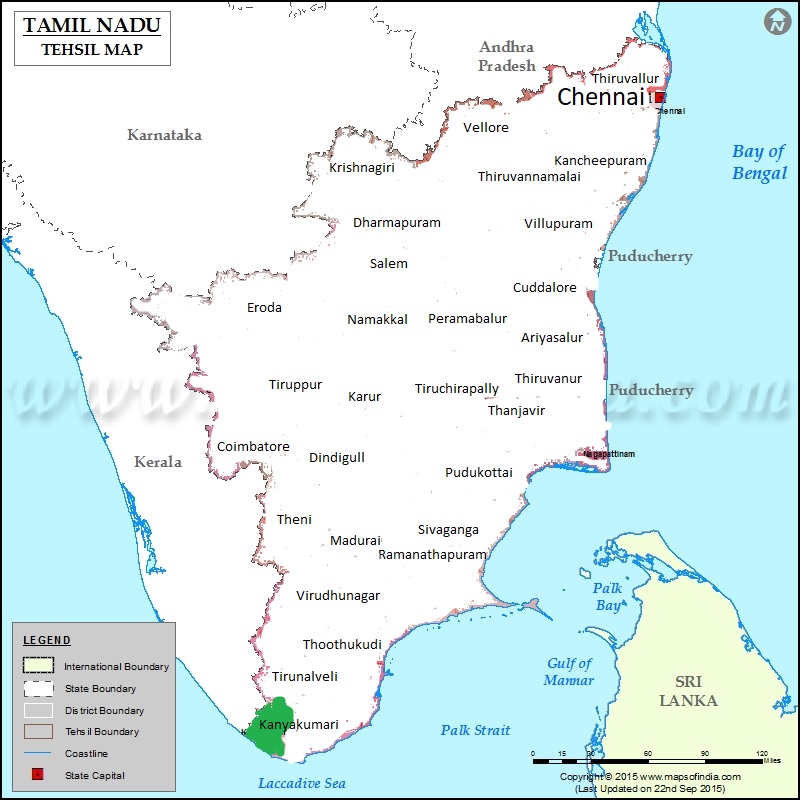
The major share of conversions come in TN from the southern most district, Kanyakumari. This is a legacy, since Kanyakumari was a part of the old Travancore state, where conversions were very heavy, but it is also important to point out that huge conversions have occurred in Kanyakumari from 1951, with the Christian population share rising from 30% to 45% in 60 years from 1951 to 2011. Two of the four tehsils are now Indic minority already. The conversions are beginning to hit Thoothkudi and Thirunelveli now, with both districts showing 10-20% Christians on paper (the real number maybe higher). In particular, the tehsils of Thiruchendur and Sathankulam in Thoothkudi and Nanguneri and Radhapuram in Thirunelveli showing high Christian population, but Indics have not fallen below 60% in any – yet.
Rajasthan and Haryana
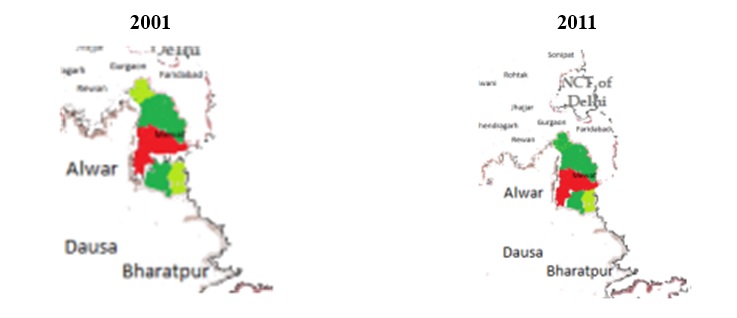
The Mewat cultural region of both Rajasthan and Haryana is showing very rapid depletion of the Hindu-Jain population. Mewat district in Haryana is the only district in Haryana that is Indic minority and all the tehsils therein are Indic minority. In many tehsils of Alwar and Bharatpur (even those not yet below the 60% Indic population mark), population is falling by as much as 5% every decade. In places like Taoru in Mewat district of Haryana, Indic population fell by 8% in the 2001-11 decade, making Indics minority from a majority in just 10 years. Further, it is important to point out that Mewat is growing into Mathura in UP, with the western tehsils of Mathura showing as much as 2% fall of Indics in the 2001-11 decade. It must be remembered that Mathura has a very high Indic population (~90%), so fall of 2% Indics per decade is very high.
States where Indic Population in Non-Indic Areas has Risen Greatly
However, the most serious rises, where the rise is greater than a lakh, come from the following states.
|
States |
2001 |
2011 |
Percentage Rise |
|
Uttarakhand |
4.63 lakh |
5.71 lakh |
23.32% |
|
Jammu & Kashmir |
5.72 lakh |
7.77 lakh |
35.84% |
|
Maharashtra |
4.51 lakh |
11.95 lakh |
164.97% |
|
Jharkhand |
8.37 lakh |
12.35 lakh |
47.55% |
|
Bihar |
17.66 lakh |
23.95 lakh |
35.62% |
|
Assam |
34.03 lakh |
43.99 lakh |
29.27% |
|
West Bengal |
66.88 lakh |
80.67 lakh |
20.61% |
|
Kerala |
74.36 lakh |
88.78 lakh |
19.39% |
|
Uttar Pradesh |
64.42 lakh |
90.53 lakh |
40.53% |
|
Total |
2.81 crores |
3.66 crores |
30.25% |
A few observations about the states are valid. One, the Roughly 90% of the total endangered Indic population resides in these 9 states, in both 2001 and 2011 census. Two, the Indic population at risk rose highest in Uttar Pradesh (26.11 lakh) followed by Kerala (14.32 lakh), and West Bengal (13.97 lakh). In terms of percentage rise, Maharashtra tops the list, with a 164.97% rise, followed by Jharkhand with 47.55% rise and then Uttar Pradesh, with 40.53% rise. Each of the states shall be analysed in clearer terms below.
Uttarakhand
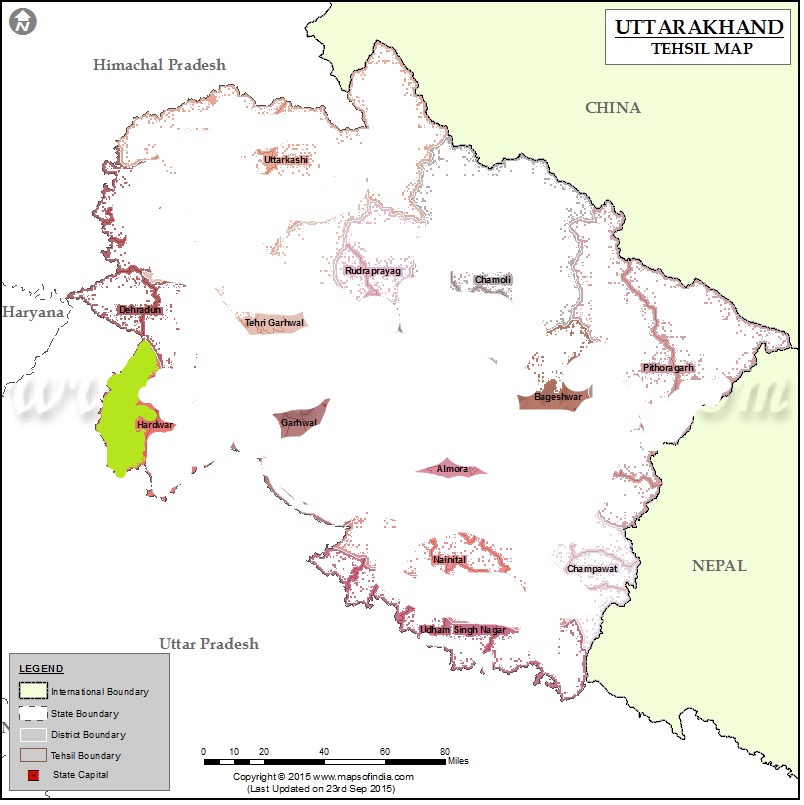
In Uttarakhand, there is only one borderline tehsil, Roorkee, which has ~43% Muslims. The population share of Indics has fallen in the tehsil by 2%. However, there are other tehsils, like Jaspur (in Shahid Udham Singh Nagar) that are fast approaching the borderline mark. However, it must be remembered that Uttarakhand began with a very high Indic population (~93%) in 1951. From there, the fall has been quite rapid to ~85.5% in 2011. Further, many of the smaller tribes in the hills like the Bhotiyas are being converted to Christianity pp. 105-106, [41], so the diversity of Uttarakhand is also under threat.
Jammu and Kashmir
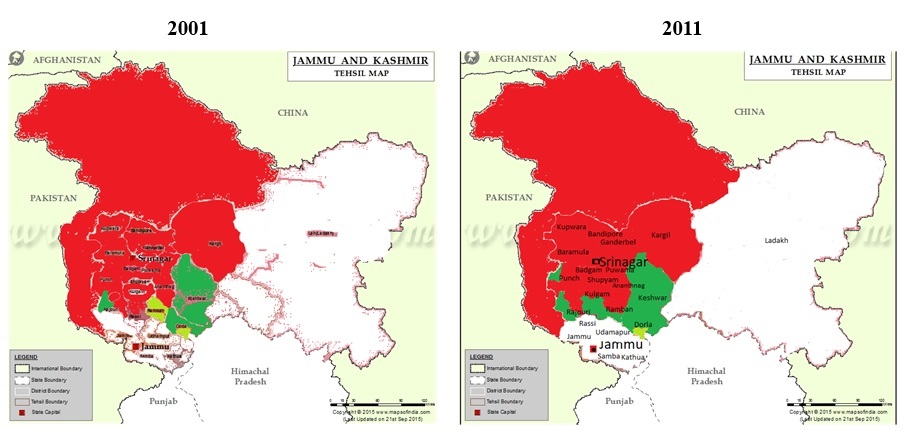
In Jammu and Kashmir, all three regions – Jammu, Kashmir and Ladakh are losing Indics. From 31% in 1961, the Indics of Kashmir rose to 35% in 1981, due to influx of refugees from Pakistan, and have since fallen to around 32% due to higher Muslim TFR. Six out of the seven districts of Hill Jammu are Hindu minority now (only Udhampur is still Hindu majority). Many places like Ramban, Kishtwar and Batote towns are registering negative Hindu growth. Tehsils like Naoshera and Ramban saw the rise of Muslims by more than 50% in the 2001-11 decade. In Ramban tehsil, Indics went from a majority to a minority in the 2001-11 decade and Indic population fell to <50% in Reasi district too. Essentially, the Hindus are being pushed south of the Chenab, which was the solution desired by the British in 1949. That solution is being de facto implemented now. In Ladakh, Indics are losing ground in absolute numbers due to the low fertility rate of the Buddhists of Ladakh. Kashmiris are also settling in many regions of Ladakh now. Kashmir Valley, of course, has been rendered Hindu free, with most of the Hindus of the region expelled.
Maharashtra
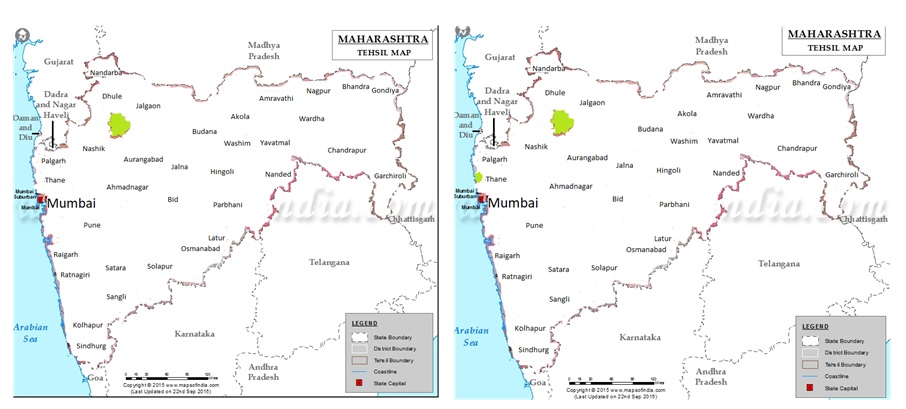
Maharashtra registered the highest rise of Indics living in <60% Indic areas – from 4.5 lakhs to 11.95 lakhs, due to the entry of the large tehsils like Bhiwandi into the borderline areas in the 2001-11 decade. Initially, it was just Malegaon among the tehsils of Maharashtra that was borderline Indic. Further, in the 2001-2011 decade, the Indic population of Mumbai district fell by as much as 3%. The bulk of Maharashtra’s Muslims are found around Mumbai and Thane districts, alongside Aurangabad and unsurprisingly, both Malegaon and Bhiwandi lost 2-4% Indics apiece. Further, Maharashtra is also beginning to see the rise of Christianity in many towns in eastern Vidarbha like Sironcha and Kamptee seeing the rise of Christianity by as much as 2-3% in a single decade (2001-11).
Jharkhand
Jharkand saw the expansion of the Indics living in non-Indic (<60% Indic) areas by 47%, from 8.37 lakhs to 12.35 lakhs. Both the north eastern & south western tribal belts show rising Christian population and the north eastern belt also shows a rapid rise of Muslims, due to ingress from the Bangladesh. The Indics are already minorities in 1 district (Simdega) in the south west and are close to 50% in two more – Sahebganj and Pakaur – in old Santhal Paraganas. It is interesting that the conversions of the tribals in the north east has skyrocketed in the north east since 1991, with the Christians growing by 280%. Conversions have also risen sharply in other parts of the state. The spread of Christianity in the tribal regions of the south west is apparent from the maps of 2001 and 2011.
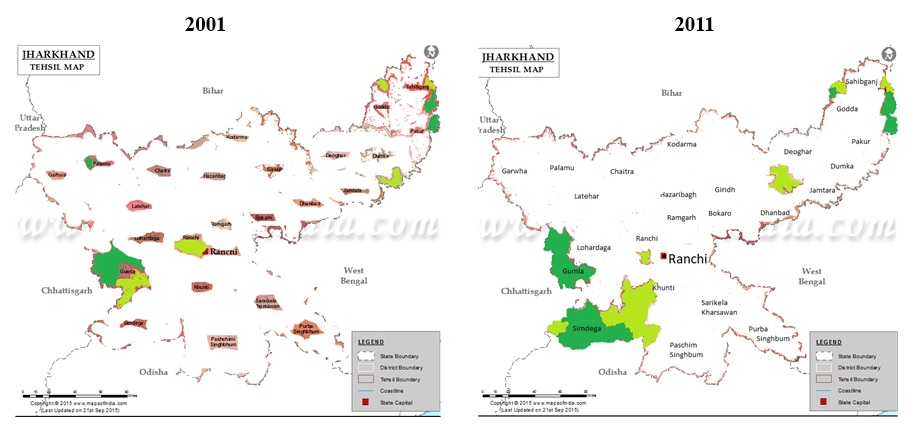
Bihar
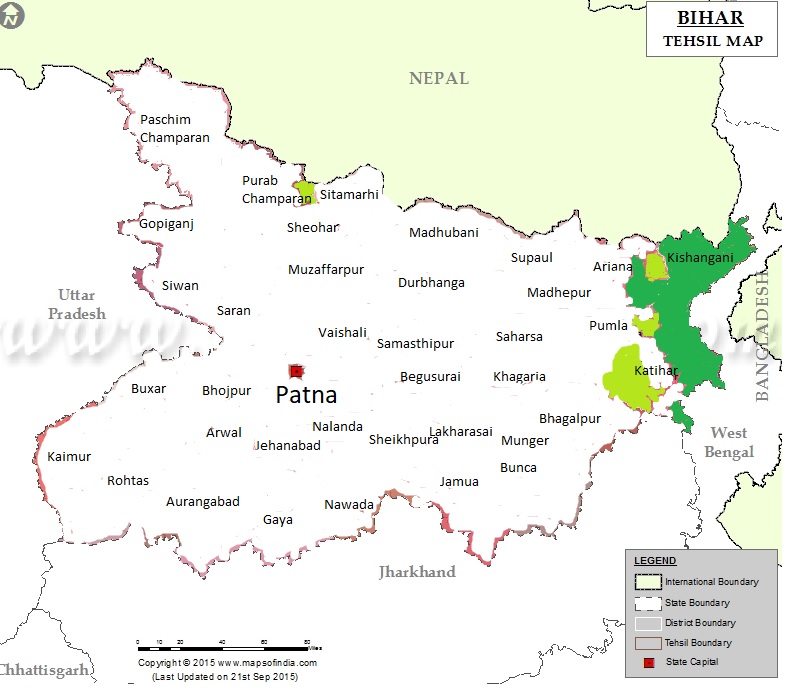
In Bihar, the north eastern part (old Purnea) is heavily Muslim, with Kishanganj district already being Muslim majority and two more (Ararea and Katihar) being borderline. Further, there are other tehsils on the Nepal border in Sitamarhi-Champaran areas that are either borderline or close to the borderline. The Muslim population of the Nepal border districts of Bihar is rising sharply. The influx of Bangladeshis into NE Bihar has risen sharply in recent years, as Bihari Muslims, unwanted in Bangladesh, are flooding across the border into Bihar. The number of Indics living in <60% Indic areas rose from 17 lakhs to 23 lakhs in 2001-11 decade.
Assam
In Assam, Indics have come down from 73% in 1951 to 61.88% in 2011. The number of Indics living in <60% Indic areas rose from 34 lakhs to 44 lakhs in a decade. Most of the tehsils of Lower Assam (West Assam) are now <60%, with many tehsils south of the Brahmaputra being either Hindu minority, or have become Hindu free. Tehsils like Kalgachia, Baghbor and Chapar show negative Hindu growth in the 2001-11 decade. Even tehsils north of the Brahmaputra are now becoming either borderline or Hindu minority. There are nine districts that are already Hindu minority (7 in Lower Assam, and 2 in the Barak Valley). Most of this is due to Bangladeshi infiltration, which is beginning to affect Lakhimpur and Sonitpur districts of Upper Assam too, and tehsils like Naoboicha and rural Tezpur in Upper Assam are borderline Indic. On the other hand, in the Barak Valley, Indics are the minority in two of the three districts, with Cachar being Hindu majority only due to the large Hindu population of Silchar town. Barak Valley as a whole is set to become Indic minority in 2021. Further, the Cachar Hills are also losing Indics fast due to significant conversion of the tribes of the region. Dima Hasao district is about 30% Christian.

West Bengal
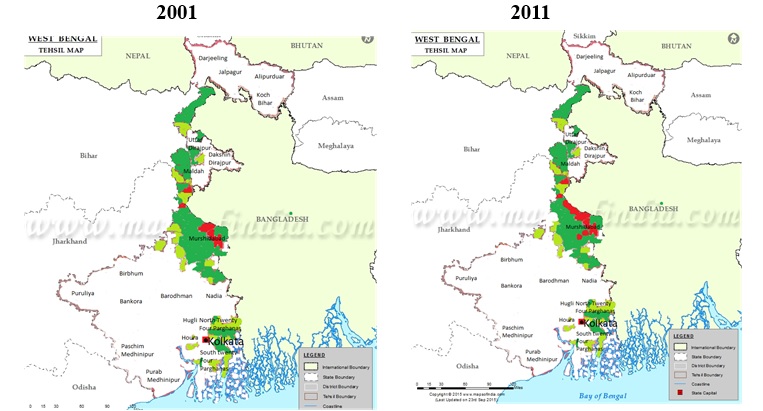
In West Bengal, there are two major pockets of non-Indics – the central districts comprising Murshidabad, Uttar Dinajpur, Maldah (all Indic minority) and Birbhum, parts of which are either Indic minority or borderline. The second non-Indic pocket is around Kolkata, east of the Bhagirathi, in both north and south 24 Paraganas districts. Both these non-Indic pockets follow the Bangladesh border, with only Nadia in the south, Dakshin Dinajpur in the centre and Jalpaiguri-Koch Behar in the north being Indic majority. The Indic population living in <60% Indic areas was 66 lakhs in 2001 and has since grown to 80 lakhs in 2011.
Kerala
Kerala had the largest number of Indics living in <60% Indic areas in 2001 – 73 lakhs. In Kerala, it is the >60% Hindu areas that have been broken up into pockets. There is a Hindu pocket comprising of southern Kasaragod and northern Kannur. There is a north central Hindu pocket comprising Northern Kozhikode and southern most Kannur. There is a Hindu pocket in central Kerala, south of Malappuram – in parts of Thrissur and Palakkad. Finally, there is a large southern pocket comprising parts of Alappuzha, Kollam, Pathanamthitta and Thiruvananthapuram. In Kerala, the Hindu population is just a shade over 50% in Malabar, is already a minority in old Cochin and a small majority in old Travancore. Of the 14 districts, Indics are already a minority in 5 districts, are borderline in 5 more and >60% only in 4 districts. There is no district where Indics are >70% in Kerala. Between 2001 and 2011, regions of Thiruvananthapuram also turned borderline Indic and the Indic minority areas spread in Palakkad district too.
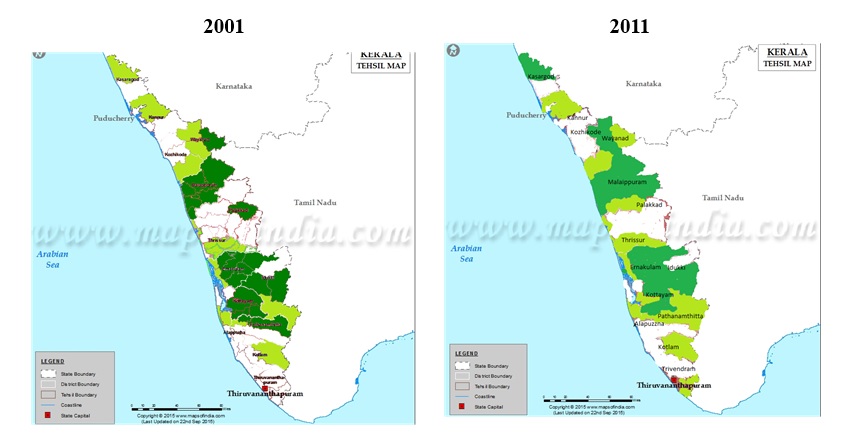
Uttar Pradesh
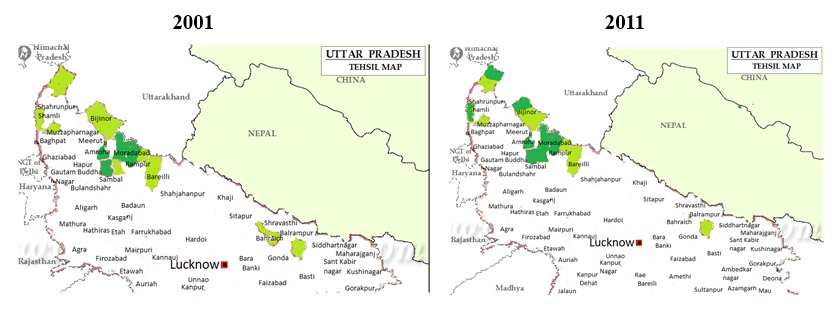
The state that has the highest number of Indics living in <60% Indic areas is Uttar Pradesh. It is interesting that the number of Indics living in <60% Indic areas in UP was 64 lakhs in 2001, which put it in the third place, behind Kerala and West Bengal for that decade. However, the number has rapidly increased in the 2001-11 decade by 26 lakhs and Uttar Pradesh has 90 lakh Indics living in <60% Indic areas. Further, this number is set to rise rapidly, as a number of other tehsils join it in the next census (especially in Meerut, and the Terai Awadh areas). There was already one tehsil (Utraula) in 2011 that was borderline Indic in Terai Awadh (The disappearance of Bahraich from the list of tehsils with 50-60% Indics between 2001 and 2011 is an artefact due to rearrangement of areas between Bahraich and Shrawasti districts). Uttar Pradesh already has one Indic minority district (Rampur) and five more in the borderline. In Rohilkhand, many tehsils in the Rampur-Bijnor-Bareilly-Moradabad belt have already become Indic minority or borderline. The most rapid fall of Indics outside the north east is occurring in the Upper Doab and the Muslim belt of the Upper Doab is rapidly expanding into Baghpat, parts of Ghaziabad and Aligarh. Many parts of Muzaffarnagar district and Saharanpur, have already become Indic minority. Apart from these tehsils becoming Indic minority, Uttar Pradesh also has a very large number of towns where Indics are a minority.
Relatively Safe States
The states of Sikkim, Punjab, Madhya Pradesh, Himachal Pradesh, Karnataka and Chhattisgarh have no population living in areas where Indics are even borderline, let alone wiped out or minority in either 2001 or in 2011. Gujarat has had one tehsil in Kutch, on the Pakistan border move into the borderline range in the 2001-2011 decade. Similarly, Andhra has just one tehsil – Rayachooty – in the borderline range. Telangana’s Indic minority areas are limited to Hyderabad city, but the number of Indics living in Indic minority areas is significant – around 6 lakhs. However, Hyderabad had no tehsils before 2011 census and consequently, the changes here cannot be analysed. Tripura has about 1.3 lakh people living in the Indic minority and borderline areas in 2011, up from 55.6 thousand in 2001, which is a fairly serious rise. The rise is mainly coming from the areas adjoining Bangladesh, where the Muslim influx is fairly serious. Similarly, Goa has only one tehsil – Salcette – that is Indic minority, with about a lakh Indics living there. However, this has remained constant, though the Christian population of Goa is 26%. And finally, in Delhi, except for Darya Ganj, no other tehsils are yet Hindu minority, and this has remained constant since 2001. There are about 2 lakh people living in Hindu minority and borderline areas, but these are once more, more or less, constant. These are the states where Indics dominate to a large extent.
Consequences of the Fall of Indic Demographics:
Indic Flight – voluntary and induced:
There have been demands that the Indics leave Indic minority areas in many cases. This has happened not only in Bangladesh and Pakistan from where Indics were forced out since they were minorities, but also in many parts of India.
In Mizoram, there have been multiple demands that Indics leave the area. Quit Mizoram Notices have been a feature of Mizoram since the 1960s, when Mizo terrorists demanded that all non-Mizo tribes and non-Christians leave the state [7]. The Reangs, adjoining Tripura, had resisted conversions, but have since been expelled from the state by Christian Mizo groups in 1997 and do not wish to return to their homes, despite official insistence on it [6]. Around 30,000 Reangs have been expelled from their homelands.
The expulsion of the Kashmiri Pandits from the Kashmir Valley due to Jihadi pressure is well known. Anywhere between 2.37 lakh to 2.87 lakh Kashmiri Pandits have been expelled from the Kashmir Valley as we conservatively estimated in [35]. There are practically no Hindus left in Kashmir valley except for the government servants and the security personnel. The counts of the Kashmir pandits left in the Kashmir valley are often as low as less than 10,000 [14].
Apart from these forced flights of the Indics under direct pressure, the Nairs have disappeared from large areas of Malappuram, the Koch, Bodos, Rabhas, Tiwa and other smaller tribes from large parts of lower Assam and Indics have fled from parts of Kairana in Western Uttar Pradesh (all these can be inferred from the census, where the collapse of Indics has been >6% per decade). Many Hindus also fled Hill Jammu when they Jihadi terrorists sought to replicate the Kashmiri religious cleansing in areas of Kishtwar pp. 18-19, [42]. It is important to point out that the Indic flight is a common phenomenon that transcends regions. Whether it is Kerala or Kashmir, Kairana or Nagaland, when Indics come under serious pressure from either Christianity or Islam, they tend to flee.
Destruction of Diversity
While it is no part of this article to minimise the conversions of the Hindus by the evangelists, it appears that the worst hit (in proportional terms) are the non-Hindu tribals. These tribals, following their unique customs and traditions and beliefs, and often inhabiting geographically remote areas, are the easiest mark for the missionaries. The unique Naga and the Kuki/Mizo faiths have nearly disappeared under the relentless assault of the missionaries. The Garo, the Khasi, the Jayantia, the Donyi Polo and the other tribal faiths of Andaman and Nicobar are fighting a last battle for their existence. Even the Sarna faiths of central India, Lepchas of Sikkim, and the Bhotias of Uttarakhand are shrinking. It is rather ironical that Christians speak of diversity, when they are the greatest destroyers of diversity in India.
.
In Nagaland, there have been many calls for a `Christian Nagaland’ p. 182, [8], non Christian Naga faiths have been brought under serious pressure with chief ministers having to disavow any sympathy for them [9], and the NSCN has persecuted other non-Christian faiths in Nagaland pp. 57-58, [10].
In Meghalaya, the animist Seng Khasi tribals in Mylliem were protesting that Christians were forbidding the cremation practices of the non-Christian tribals [24].
In Arunachal Pradesh, there have been numerous attempts at forcible conversion of the Indic faiths, as pointed out here [12].
Riots
There have been several riots in recent years, and almost all of them have occurred in regions where Indic population is low. Major riots include Kaliachak (10-33% Indic) and Basirhat (30-50% Indic) in Bengal, Marad in Kerala (47% Indic), Kokrajhar in Asom (40-60% Indic), Muzaffarnagar in Uttar Pradesh (46-54% Indic), Kishtwar in Jammu and Kashmir [15] (42% Indic). The Imphal valley of Manipur, connected to the remainder of India through the Tamenglong and Senapati districts, is often blockaded by the Christian Nagas [11]. Many blockades of Manipur valley have been initiated and the most recent one was just last year [11].
On the topic of security for Hindus, it is important to observe that Indics, especially those who are activist in the Indic cause, can be slaughtered by Islamists even in Indic majority areas. The best example of this is the recent Basirhat riot. Basirhat is situated in the N 24 Paraganas district, which is ~73% Indic. However, the Basirhat riot specifically in the Basirhat-Baduria region (30-50% Indic) of the N 24 Paraganas that is Indic minority.
Murder of Indic Leaders
A variant of the riots is the slaughter of the Indic political activists by various Islamist organisatons (including Popular Front of India and Al-Ummah) in the southern states of Kerala, Karnataka and Tamizh Nadu. Below, we shall highlight a series of murders that have been perpetrated by these organisations. It is interesting that the murders have occurred in Vellore (2 murders), Ramanathapuram, Salem, Madurai and Chennai. [26]. It is of further interest that Ramanathapuram tehsil has 27% Muslims (a very high percentage for Tamizh Nadu) and Vellore town has 24% Muslims and Chennai has a very large Muslim population (4.4 lakhs), even if percentage is lower (9.45%), which would provide the extremists a very easy locale in which they can blend. Similarly, a series of murders in Karnataka have occurred around the district of Dakshin Kannada [27], and the cities of Madikeri [28], Shimoga town [32], Mysore [29] and Bangalore [27]. Once more, the common denominator is that Dakshin Kannada has 24% Muslims, Madikeri town has 23% Muslims, Shimoga town has 24% Muslims, Mysore has 22% Muslims and Bangalore has 16% Muslims, but the number is huge (11.9 lakhs). The situation is even worse in Kerala. The situation is even worse in Kerala, with the Kerala government formally submitting that the Popular Front of India (PFI) was involved in the murder of 27 people, mostly BJP/RSS or CPM activists [30]. The PFI was also running a terror camp at Narath in Kannur [31], was involved in the murder of students in Mysore [29], and been involved in the Pune, Mumbai and Hyderabad blasts [33]. Malabar in North Kerala (where Kannur is located) has a high Muslim population with Muslims constituting more than 25% in all the districts except Thrissur (17%).
The same phenomenon has been seen in places where the Evangelists have achieved local dominance. Indic religious leaders are the target of the Christianist terrorists. Swami Lakshmananada was killed in Tumudibandha tehsil [37] of Kandhamal district, which is only 63.6% Indic, with the rest being mostly Christian. The same phenomenon has been seen in parts of Tripura where Hindu sants like Shanti Kali Maharaj and Jaulushmoni Jamatia, who lived on the borders of tehsils with substantial Christian population (~14%) have been killed by the NLFT (National Liberation Front of Tripura, a Christian terrorist outfit) [38].
Implications for Territorial Integrity of India
It is interesting to observe that all the secessionist movements that have continued over a long time have come from regions that are dominated by non-Indics. Kashmir Valley has seen a call for separation since the late 1980s and there is no sign of the secessionism abating. Similarly, Nagaland has seen a secessionist movement that has continued unabated since Indian independence. There are many factions of the NSCN (a Naga terrorist movement, whose leaders have called for `Nagaland for Christ’ p. 182, [8]) that are still actively working for an independent Nagaland. This was also the experience of the Indian National Army (INA) soldiers. Mohammad Zaman Kiani, Commander of the INA, recorded his memories about the behaviour of the Christian tribals when INA reached Nagaland: ``the border area, where fighting took place, was inhabited by and large by the Naga and Chin Tribes who were Christian by faith and had more in common with the British than with the Japanese or the INA. To cite an example; just as fighting stalemated on the Palel front, an English-speaking young Naga woman came over to the 2nd Regimental HQs, ostensibly to work as an informer but actually to spy for the British. After staying for a few days she slipped back into the jungle, as soon as she got the opportunity !’’ p. 124 [39] (Kiani was a Muslim by faith, and had written his memoirs several years after he had moved to Pakistan, so surely he can not be accused of Hindu fundamentalism). Similarly, when the Chinese invaded in 1962, the illegal Muslim immigrants from the then East Pakistan (current Bangladesh) welcomed the Chinese army with white and Pakistani flags in Nagaon and Darrang p. 107, [40] (both Nagaon and Darrang have Muslim populations >30%). It is further interesting to observe that there has been no prolonged secessionist movement in the Indic majority areas. Certainly, there have been rumblings at times, but never a prolonged movement – the ULFA and the Khalistani movements barely lasted 15 years and they were the worst movements. Further, in Tamizh Nadu, there were a few mutters about secession from the Indian Union in the aftermath of independence, but it never got much traction. Secessionism in Punjab, Tamizh Nadu and Asom, which are all Indic dominated, never made much headway because large sections of the Indics remained loyal to India and put their faith in the Indian Union. It would appear that Indics are the best guarantees of territorial integrity of India.
Conclusion
In this article, we have analysed the numbers and the changes that have occurred in the various parts of India. In the next article, we shall analyse the causes for the fall of the Indic population and the possible solutions and non-solutions for the fall of Indic population proportions.
References
[1] Beverley, ``Report on the census of Bengal 1872’’
[2] Gopi Krishan, ``Demography of the Punjab (1849-1947)’’ http://www.global.ucsb.edu/punjab/sites/secure.lsit.ucsb.edu.gisp.d7_sp/files/sitefiles/journals/volume11/no1/6_krishan.pdf
[3] AP Joshi, MD Srinivas, & JK Bajaj, ``Religious Demography of India’’, Centre for Policy Studies
[4] Census of India, 2011.
[5] Census of Bangladesh, 2011.
[6] Reangs expelled from Mizoram http://www.firstpost.com/fwire/refugees-dont-leave-tripura-for-mizoram-1575467.html
[7] Quit Mizoram Notices http://www.epw.in/journal/2014/25/reports-states-web-exclusives/quit-mizoram-notices.html
[8] Prasenjit Biswas, Chandan Shuklabaidya, ``Ethinc Life Worlds in North-East India’’
[9] ``Not Promoting Heraka, I am a devout Christian: Nagaland CM’’ http://www.newindianexpress.com/nation/2017/jul/27/not-promoting-heraka-i-am-devout-christian-nagaland-chief-minister-tr-zeliang-1634421.html
[10] Kunal Ghosh, ``Separatism in North East India’’
[11] Naga blockade of Manipur http://www.firstpost.com/india/manipur-economic-blockade-shows-that-the-naga-peace-talks-have-failed-3214886.html
[12] Socio-Cultural Destabilisation of Arunachal Pradesh, Vivekananda International Foundation. http://www.vifindia.org/article/2011/april/5/Socio-Cultural-Destabilisation-of-Arunachal-Pradesh-by-Insurgent-Groups-and-other-Anti-National-Forces
[13] Forcible conversion of the Buddhists of Arunachal, http://www.buddhistchannel.tv/index.php?id=70,9573,0,0,1,0#.WaGWDBdMFFQ (article appeared in Indian Express, 28 May, 2010).
[14] Kashmiri Hindus: Driven out and insignificant http://www.bbc.com/news/world-asia-india-35923237
[15] Kishtwar Riots indicts Sajjad Kitchloo http://indianexpress.com/article/india/india-others/final-report-on-2013-kishtwar-riots-triggers-fresh-controversy/
[16] Praveen Patil, ``Muzaffarnagar: Where the Riots turned to Pathology from Anatomy’’. https://swarajyamag.com/featured/muzaffarnagar-where-riots-turned-into-pathology-from-anatomy
[17] Thomas Joseph Commission Inquiry: Marad Communal Disturbances Report https://archive.org/stream/ThomasPJosephCommissionOfInquiry-maradCommunalDistrabances/marad-report-part-II1_djvu.txt
[18] ``Violence leaves North Kerala bloody’’ http://www.hindustantimes.com/india-news/violence-leaves-north-kerala-bloody-as-political-equations-change/story-PmvnXLtkX97ST57NJX8a2H.html
[19] As Calm Descends, Kokrajhar groups see hidden hand. http://www.thehindu.com/news/national/other-states/as-calm-descends-kokrajhar-groups-see-hidden-hand-behind-violence/article3728315.ece
[20] Anti Conversion Laws https://www.loc.gov/law/help/reports/pdf/2017-014600.pdf
[21] Home Ministry Annual Report 2013-14 http://mha.nic.in/sites/upload_files/mha/files/AR(E)1314.pdf
[22] Home Ministry Annual Report 2016-17 http://mha.nic.in/sites/upload_files/mha/files/anual_report_18082017.pdf
[23] Shanmukh, Saswati Sarkar and Dikgaj, ``Examining the Indo-Bangla Land Boundary Agreement’’ http://indiafacts.org/examining-the-indo-bangla-land-boundary-agreement/
[24] Cremation of Seng Khasi elder faces protest, https://thenortheasttoday.com/meghalaya-cremation-of-seng-khasis-elder-faces-stern-opposition-from-locals/
[25] VP Menon, ``Transfer of Power in India’’
[26] Murder of Rightwing leaders in Tamil Nadu linked to Al Ummah, http://indianexpress.com/article/india/india-others/murders-of-right-wing-leaders-in-tamil-nadu-linked-to-terror-group-al-ummah/
[27] Karnataka, Another Hindu Killing Field https://hinduexistence.org/2017/03/17/karnataka-another-hindu-killing-field-and-destination-of-bloody-jihad-in-south/
[28] Tipu Controversy: Two arrested for killing of VHP activist http://timesofindia.indiatimes.com/india/Tipu-controversy-Two-arrested-for-death-of-VHP-activist-in-Madikeri/articleshow/49796556.cms
[29] The Carpenter of Mysore and the murders no one suspected him of http://indianexpress.com/article/india/india-news-india/abid-pasha-mysuru-murders-revelations-religious-leaning-carpenter-bajrang-dal-2991215/
[30] PFI is SIMI in another name http://archive.indianexpress.com/news/pfi-is-simi-in-another-form-kerala-govt-tells-hc/979440/
[31] Kerala Cops confirm PFI terror camp in Kannur http://www.dailypioneer.com/nation/kerala-cops-confirm-popular-front-terror-camp-in-kannur.html
[32] Man dies of group attacks him after communal clash http://www.deccanherald.com/content/460915/man-dies-group-attacks-him.html
[33] Popular Front of India’s role in 2011 Mumbai, 2012 Pune, and 2013 Hyderabad blasts found. http://timesofindia.indiatimes.com/india/Popular-Front-of-Indias-role-in-2011-Mumbai-2012-Pune-2013-Hyd-blasts-found-Intel-agencies/articleshow/46710055.cms
[34] Medha Kudaisya, ``The Life and Times of GD Birla’’
[35] Shanmukh, TrueIndology, Aparna, Saswati Sarkar and Dikgaj, ``Demographic Expansion of Kashmir and the Shrinking of Jammu and Ladakh’’, https://www.myind.net/Home/viewArticle/demographic-expansion-kashmir-and-shrinking-jammu-and-ladakh
[36] https://indiamission.org/where-we-work
[37] Swami Lakshmanananda Saraswati Murder Case – 7 accused found guilty. http://zeenews.india.com/news/odisha/swami-lakshmanananda-saraswati-murder-case-7-accused-found-guilty_880141.html
[38] http://news.bbc.co.uk/2/hi/south_asia/899422.stm
[39] Mohammad Zaman Kiani, ``India’s Freedom Struggle and the Great I.N.A.’’
[40] Braja Bihari Kumara, ``Illegal Immigration from Bangladesh''.
[41] Alexander McLeish, ``The Frontier Peoples of India’’
[42] GD Bakshi, ``The Kishtwar Cauldron’’
1. The 1941 census in Bengal was very cursory due to the disturbed conditions prevailing therein and the distraction of the war. Consequently, it makes more sense to consider the 1931 census for this province.
2. The references of both Punjab and Bengal are for British Punjab & British Bengal. The princely states held their own census.
3. The last census in Pakistan was held in 1998. A new census has been started in 2017, but the full figures have not yet been released, so the exact figures for Pakistan in 2011 are not available. They have been extrapolated from the numbers available in 1998.
4. The rise of the Indics living in Indic minority tehsils in Andhra Pradesh is an artefact. There were no tehsils in Hyderabad district in 2001, so the rise in Andhra Pradesh is due to the creation of tehsils in this district, which originally had none. Consequently, this cannot be analysed and has been ignored.
5. The tehsil boundaries in many states have been changed, so the comparison between 2001 and 2011 suffers from some flaws, since it is not possible to have a direct comparison. But the general conclusions hold.
Disclaimer: The opinions expressed within this article are the personal opinions of the author. MyIndMakers is not responsible for the accuracy, completeness, suitability, or validity of any information on this article. All information is provided on an as-is basis. The information, facts or opinions appearing in the article do not reflect the views of MyindMakers and it does not assume any responsibility or liability for the same.



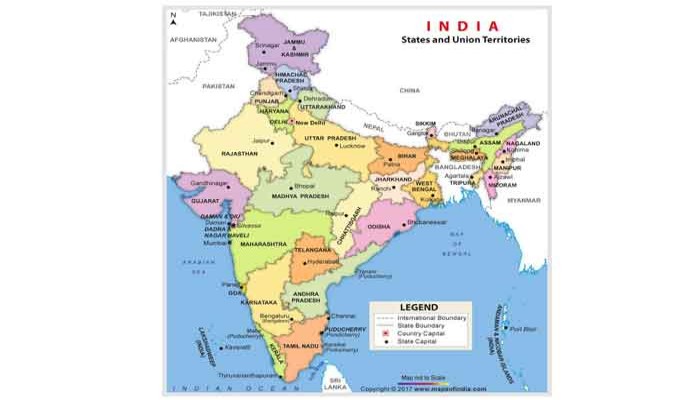



Comments